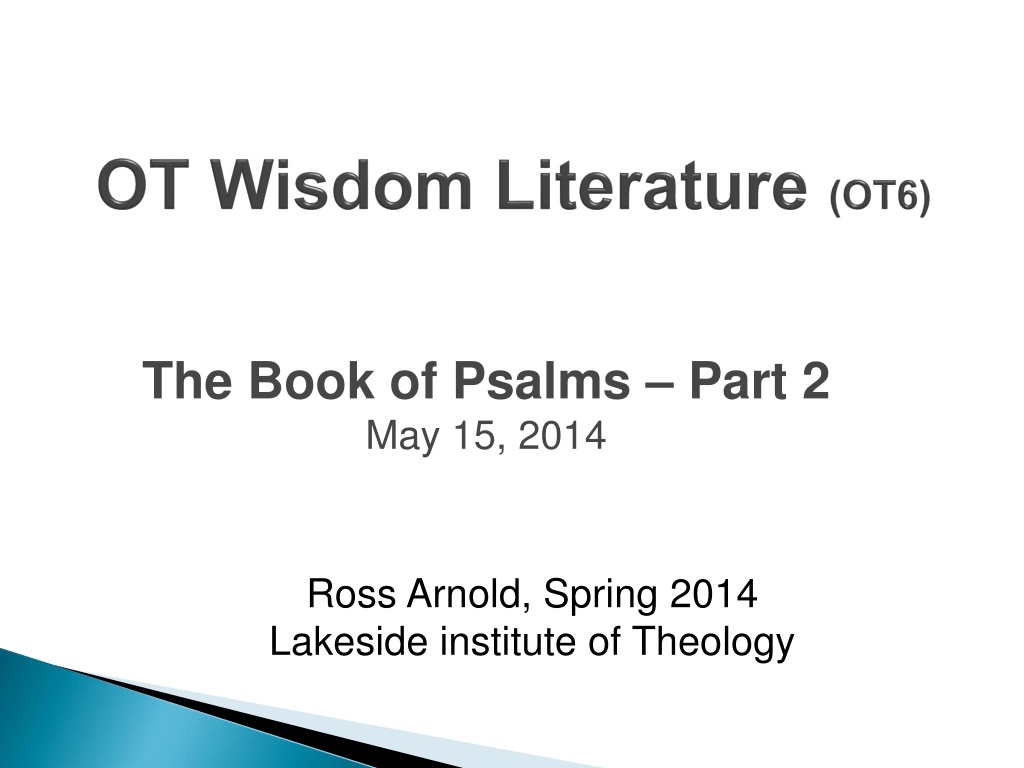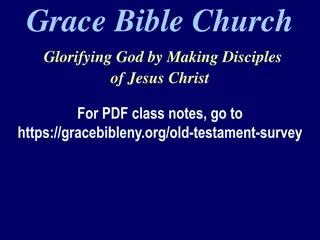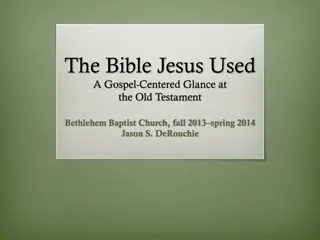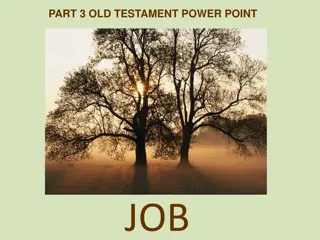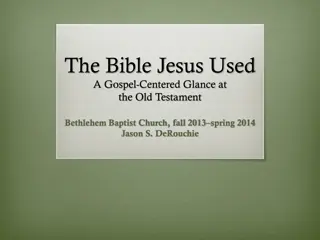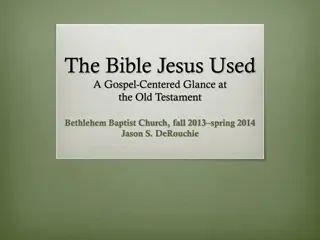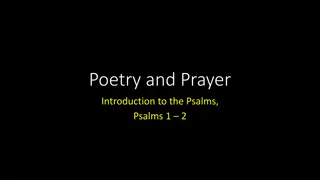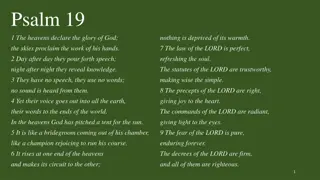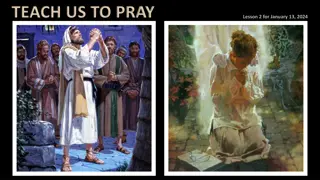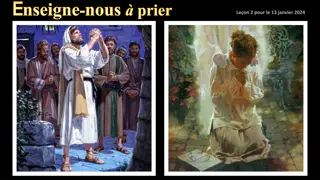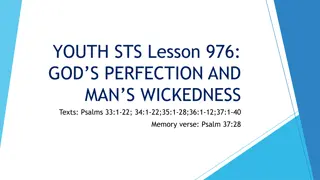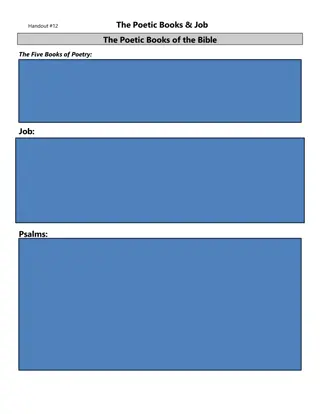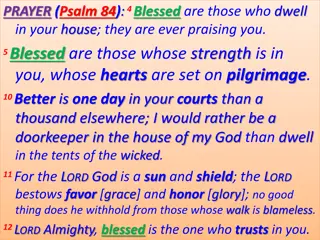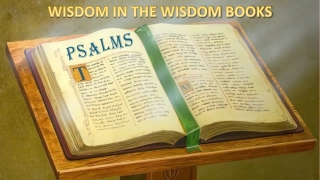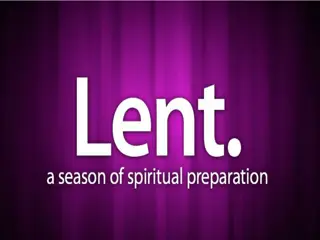Understanding the Book of Psalms: An Overview of Themes and Structure
The Book of Psalms, also known as Tehillim, is a collection of prayers, poems, and hymns attributed to various authors such as King David, Solomon, and Moses. It is the longest book in the Bible, with diverse themes including worship, wisdom, judgment, and the Messiah. Divided into five sections, each closing with a doxology, Psalms serve as a worship hymnal for ancient Israel and beyond, addressing both communal and individual experiences through various forms like praise, lament, royal, and wisdom psalms.
Download Presentation

Please find below an Image/Link to download the presentation.
The content on the website is provided AS IS for your information and personal use only. It may not be sold, licensed, or shared on other websites without obtaining consent from the author. Download presentation by click this link. If you encounter any issues during the download, it is possible that the publisher has removed the file from their server.
E N D
Presentation Transcript
The Book of Psalms Part 2 May 15, 2014 Ross Arnold, Spring 2014 Lakeside institute of Theology
OT Wisdom Literature (OT6) Apr 3 Introduction to Wisdom Literature Apr 10 The Book of Job Apr 17 No Class (Holy Week) Apr 24 The Book of Psalms, Part 1 May 1 No Class May 8 No Class May 15 The Book of Psalms, Part 2 May 22 The Book of Proverbs May 29 The Book of Ecclesiastes June 5 The Song of Songs; Final Exam
Law/History 5+12 Wisdom 5 Prophets 5+12 39 27 66 3
Title: The Hebrew name for the book is Tehillim, or Praises. The Greek translation, psalmoi, means instrumental music. Author: Seventy-three of the Psalms have superscriptions identifying King David as their author. Two (Ps. 72 & 127) are attributed to Solomon; Ps. 90 identifies Moses as its author; twelve Psalms (50, and 73-83) are ascribed to the family of Asaph; eleven Psalms (42, 44-49, 84-85, 87-88) are credited to the Sons of Korah; Ps. 88 is attributed to Heman; and Ps. 89 is assigned to Ethan the Ezrahite. Fifty Psalms do not identify their authors. Date of Writing: If Moses did write Psalm 90 it would be the earliest, around 1450 BC; while Psalm 137 was apparently written during the Babylonian Captivity, around 586-538 BC. They were probably brought together into their present form shortly after the Captivity around 537 BC. 4
Recipients: The ancient Jewish people, and everyone since. Themes: The Book of Psalms is the longest book in the Bible, with 150 chapters or individual psalms. It is also one of the most diverse, dealing with subjects such as God and his creation, war, worship, wisdom, sin and evil, judgment, justice, and the coming of the Messiah. Content: The Book of Psalms is a collection of prayers, poems and hymns that served as the worship hymnal from ancient Israel, leading worshipers into praise and adoration of God. Structure: The Book of Psalms is a divided into Five Sections, each closing with a doxology: Book 1 Psalm 1-41 Book 2 Psalm 42-72 Book 3 Psalm 73-89 Book 4 Psalm 90-106 Book 5 Psalm 5
Types of Psalms: The simplest view of the Psalms identifies TWO forms Psalms of Praise; and Psalms of Lament. But others have proposed the following Psalm forms: 1. Hymns songs of praise for God and his work in creation. 2. Communal Laments in which the nation laments some common disaster. 3. Royal Psalms dealing with the king and events in his life. 4. Individual Laments lamenting events in the life of an individual. 5. Individual Thanksgiving Psalms in which an individual gives thanks for blessings. 6. Wisdom Psalms similar to Proverbs. 7. Psalms of Remembrance recollecting past events, especially God s great work on behalf of the Israelites. 8. Judgment Psalms visiting curses on enemies. 6
Hebrew Parallelism: A poetic form in which two or three parallel phrases are used to give variations on a them, to emphasize a point. 1. Synonymous Parallelism in which the content of a first phrase is repeated in different words for emphasis. Psalm 1:1: Blessed is the man who does not walk in the counsel of the wicked or stand in the way of sinners or sit in the seat of mockers. 2. Antithetic Parallelism: in which the content of a second phrase is contrasted sharply with the first phrase. Psalm 1:6 For the Lord watches over the way of the righteous, but the way of the wicked will perish. 7
Hebrew Parallelism: A poetic form in which two or three parallel phrases are used to give variations on a them, to emphasize a point. 3. Synthetic Parallelism in which the content of a second phrase takes the thought of the first phrase further. Psalm 1:2 But his delight is in the law of the Lord, and on his law he meditates day and night. Alphabetical Acrostics: in which the poets constructs line segments based on letters of the Hebrew alphabet. 1. Line segment acrostics on which each line segment is linked to a letter. (Psalm 111-112) 2. Single line acrostics (Psalms 25, 34, 145) 3. Two line acrostics (Psalm 37) 4. Eight line acrostics (Psalm 119) 8
Psalm 22. The Suffering Servant Psalm 23. The Good Shepherd Psalm 24. The Sovereign King
Hope in God, for I shall again praise Him For the help of His presence (Psalm 42:5). Hope in God, for I shall yet praise Him, The help of my countenance and my God. (Psalm 42:11). Hope in God, for I shall again praise Him, The help of my countenance and my God. (Psalm 43:5).
Give thanks to the Lord, for he is good; his love endures forever. 2 Let Israel say: "His love endures forever." "His love endures forever." "His love endures forever." 3 Let the house of Aaron say: 4 Let those who fear the Lord say: Psalm 118:1-4
